Prepaid Wireless Service Providers anticipated to Lead Implementation of AI in CRM. Wireless Carriers will Simultaneously Lower Costs and Improve Customer Satisfaction via AI Based Customer Care
Speak directly to the analyst to clarify any post sales queries you may have.
This Management Strategy Report is part of the Insight Series that identifies developing market trends and provides vision into the market impact of emerging and disintermediating technologies. This offering includes expert Q&A as well as one hour of interactive consultation to answer your pressing technology and/or business issues. Additional consulting, advisory services, and/or research customization are available upon request.
Prepaid wireless has gained parity with postpaid in terms of plans, feature functionality, and even pricing. However, prepaid wireless customer care remains sub-par compared to postpaid service. In addition, prepaid service providers typically have their own customer care teams, even within host carriers (e.g. not just with MVNO providers), which can cause many issues including customer migration from postpaid to prepaid (or vice versa), plan differences, and phone related issues.
Based on primary research into prepaid wireless service provider customer care, it is believed that prepaid wireless service providers (and some post-paid service MVNOs) will be the likely first and best target service areas for AI based CRM. More specifically, carriers will look beyond AI based chatbots and other online CRM automation tools towards conversational AI, which will become very important for both cost reduction and customer satisfaction. This is because conversational AI will provide the best combination of human-like interaction, but with the full knowledge base of carrier service information. AI in prepaid wireless customer care will not be limited to conversational AI, however, as machine learning will also be a powerful tool to identify trends in customer care. This will allow carriers to proactively deal with potential customer concerns before they become systemic problems.
The downside from an employment perspective is that many low-level customer care personnel jobs will be eliminated. Wireless carriers are recommended to restructure and retrain personnel in preparation for implementing AI in CRM. Part of this preparation should involve elimination of wrote engagement such as scripts used by customer care in favor of reps becoming more intuitive and active listeners. Additional insights from our primary research along with recommendations are found in the report.
This report will enable the purchaser to have a better understanding of future customer care operations within the communications service provider (CSP) market segment. Buyers of this report will be able to identify how CSPs will simultaneously cut operational costs and improve end-user satisfaction via AI-based customer care. In addition, the buyer will gain a better understanding of how AI-enabled CRM will evolve and integrate with business operations within many industry verticals.
Key Findings
- Customer care at incumbent MNOs is highly bifurcated
- AI will provide both cost reduction and customer satisfaction
- Best tool for automated wireless customer care is conversational AI
- Best tool for data analytics and customer-facing decisions is machine learning
Target Audience
- AI companies
- Prepaid service providers
- Mobile network operators
- Wireless device manufacturers
- Wireless infrastructure providers
- Mobile Virtual Network Operators
- Mobile application store companies
- Prepaid service distributors and marketers
- Application, content and commerce providers
With the purchase of this report at the Multi-user License or greater level, you will have access to one hour with an expert analyst who will help you link key findings in the report to the business issues you're addressing. This will need to be used within three months of purchase.
This report also includes a complimentary Excel file with data from the report for purchasers at the Site License or greater level.
Table of Contents
1. Executive Summary
Methodology

LOADING...








